Coupling Photosynthetic Measurements with Biometric Data to Estimate Gross Primary Productivity (GPP) in Mediterranean Pine Forests of Different Post-Fire Age
Abstract
:1. Introduction
2. Materials and Methods
2.1. Study Sites
2.2. Gas Exchange and Functional Traits Measurements
2.3. Stand Level Measurements
2.4. Environmental and Remote Sensing Data
2.5. Statistical Analysis
2.6. Coupling Biometric and Gas Exchange Data to Simulate Stand Level GPP
2.6.1. Big Leaf Model
2.6.2. Sun/Shade Model
3. Results
3.1. Variation in Stand Structure across the Post-Fire Chronosequence
3.2. Foliage Properties and Their Seasonal Variation
3.3. GPP Simulations
4. Discussion
5. Conclusions
Author Contributions
Funding
Institutional Review Board Statement
Informed Consent Statement
Data Availability Statement
Acknowledgments
Conflicts of Interest
Appendix A
| Plot Age (years) | Clay % | Silt % | Sand % | Soil Texture | Soil Depth (cm) |
|---|---|---|---|---|---|
| 13 | 62.73 | 19.9 | 17.37 | clay | 28.3 |
| 40 | 48.73 | 17.97 | 33.3 | clay | 26.6 |
| 72 | 61.66 | 12.86 | 25.48 | clay | 29.2 |
| 92 | 52.15 | 17.37 | 30.48 | clay | 34.8 |
| Symbol | Data Source/Value | Definition and Units |
|---|---|---|
| Id | from Solcast data | Diffuse PAR per unit ground area (μmole quanta m−2 s−1) |
| Ib | from Solcast data | Beam PAR per unit ground area (μmole quanta m−2 s−1) |
| rcd | 0.036 | Canopy reflection coefficient for diffuse PAR (unitless) |
| sc | 0.15 | Leaf scattering coefficient of PAR (unitless) |
| kds | 0.719 | Diffuse and scattered diffuse PAR extinction coefficient (unitless) |
| kbs | 0.46 ⁄ sin β | Beam and scattered beam PAR extinction coefficient (unitless) |
| kb | 0.5 ⁄ sin β | Beam radiation extinction coefficient of canopy (unitless) |
| rh | Reflection coefficient of a canopy with horizontal leaves (unitless) | |
| rcb | Canopy reflection coefficient for beam PAR (unitless), exp is the exponential function |
| Parameter | 13 Year-Old | 40 Year-Old | 72 Year-Old | 92 Year-Old |
|---|---|---|---|---|
| LMA cv (%) | 10.8 | 13.0 | 12.5 | 10.0 |
| Asat cv (%) | 49.5 | 39.8 | 31.3 | 33.2 |
| Km cv (%) | 44.2 | 45.5 | 35.5 | 41.2 |
| Rd cv (%) | 50.3 | 63.3 | 60.2 | 52.0 |
| Plot Age | Lighting Condition | Asat Mean (μmole CO2 m−2 s−1) | p-Value Asat | Km Mean (μmole quanta m−2 s−1) | p-Value Km | Rd Mean (μmole CO2 m−2 s−1) | p-Value Rd | Asatsh /Asatsun | Kmsh /Kmsun | Rdsun /Rdsh |
|---|---|---|---|---|---|---|---|---|---|---|
| 13 year-old | shade | 10.23 | 0.571 | 304.44 | 0.191 | 0.50 | 1.000 | 0.89 | 0.70 | 1.00 |
| 13 year-old | sun | 11.52 | 434.74 | 0.50 | ||||||
| 40 year-old | shade | 7.38 | 0.371 | 189.33 | 0.019 | 0.43 | 0.622 | 0.79 | 0.59 | 1.40 |
| 40 year-old | sun | 9.35 | 319.04 | 0.31 | ||||||
| 72 year-old | shade | 9.13 | 0.214 | 289.34 | 0.683 | 0.29 | 0.461 | 0.92 | 0.92 | 0.84 |
| 72 year-old | sun | 9.89 | 312.98 | 0.34 | ||||||
| 92 year-old | shade | 8.75 | 0.679 | 258.81 | 0.594 | 0.62 | 0.129 | 0.91 | 0.84 | 0.93 |
| 92 year-old | sun | 9.57 | 306.75 | 0.67 | ||||||
| ALL | shade | 8.60 | 0.171 | 250.43 | 0.007 | 0.47 | 0.367 | 0.87 | 0.76 | 1.00 |
| ALL | sun | 9.87 | 331.38 | 0.47 |
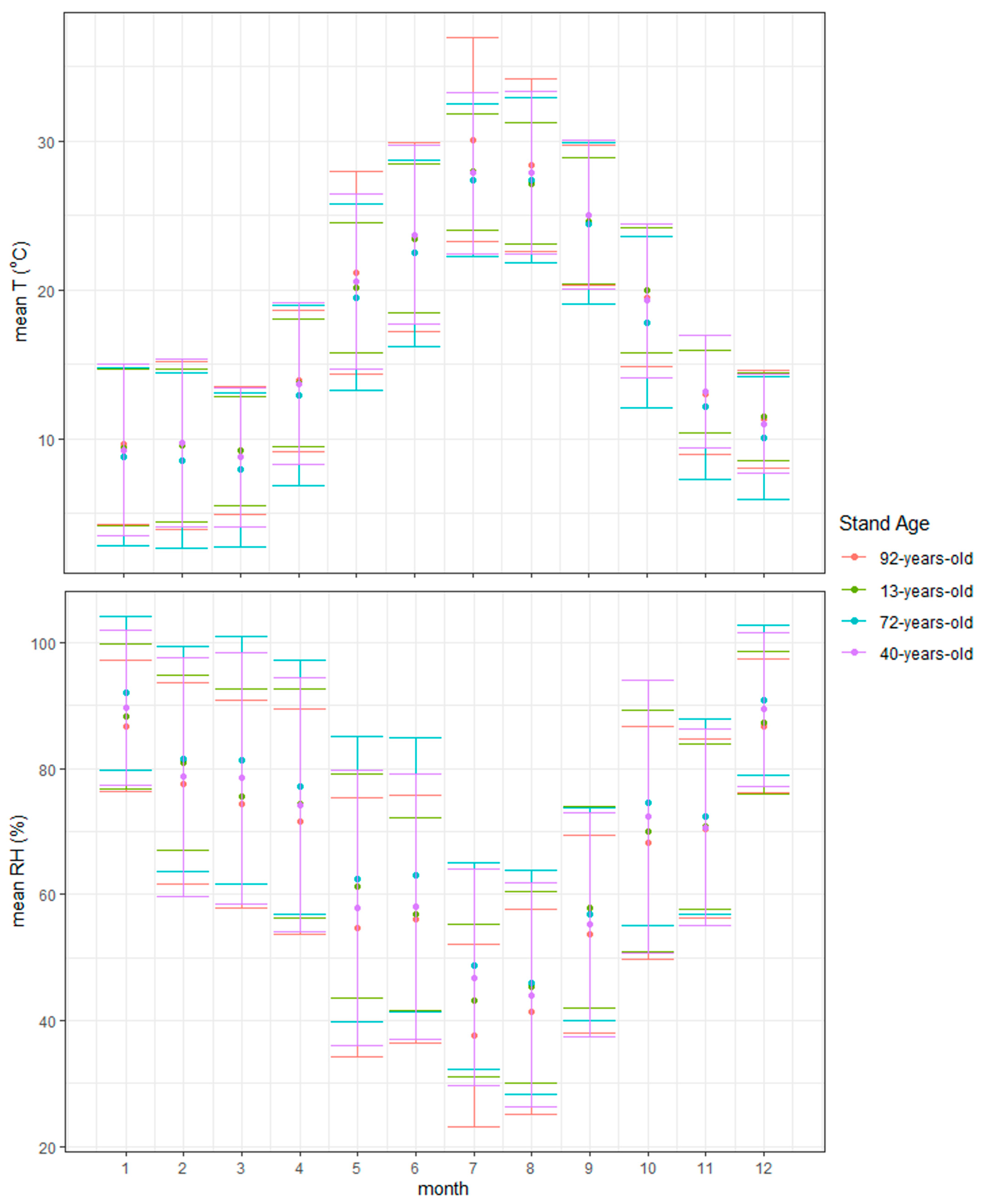
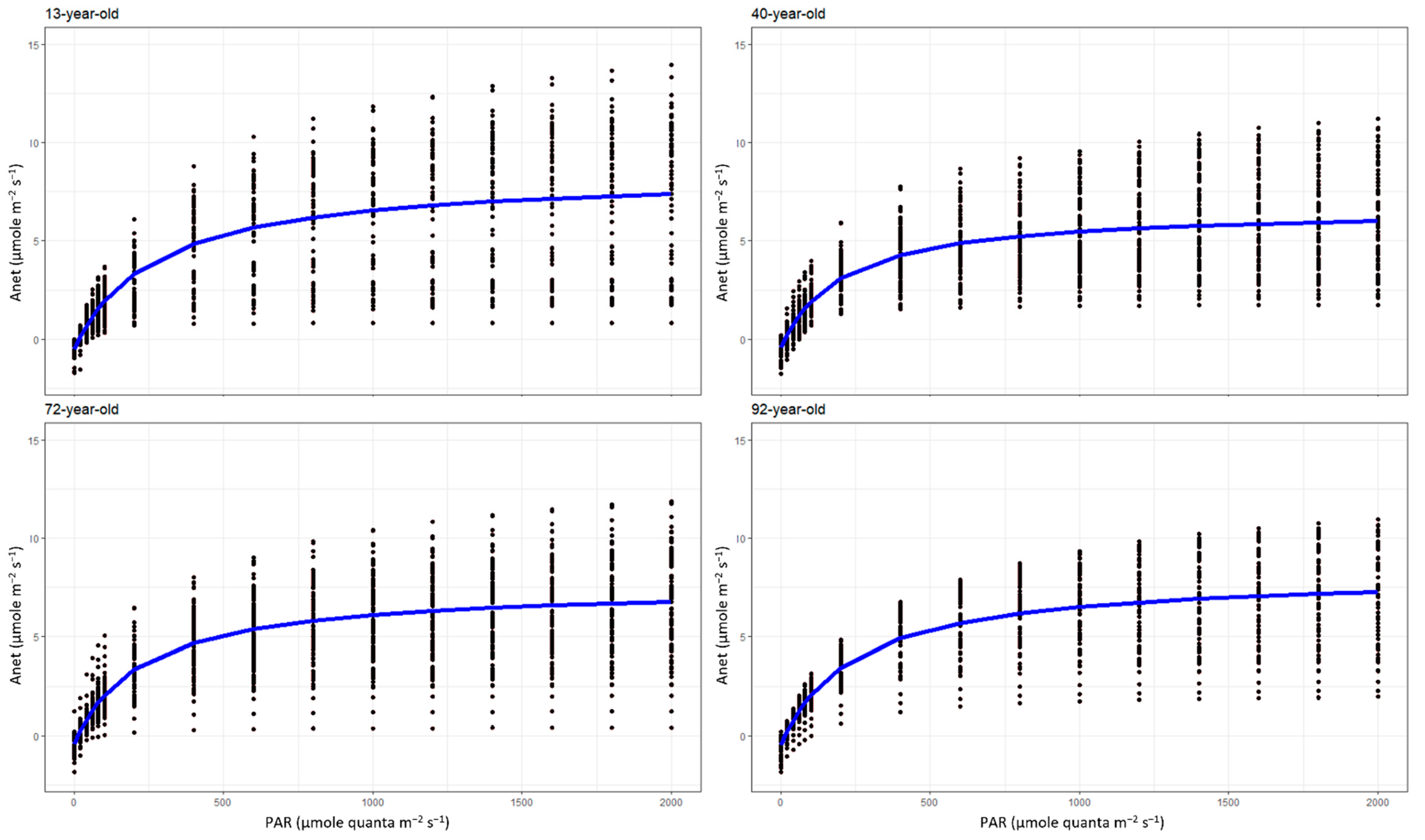
References
- Pukkala, T. Which Type of Forest Management Provides Most Ecosystem Services? For. Ecosyst. 2016, 3, 9. [Google Scholar] [CrossRef] [Green Version]
- Rai, P.B.; Sears, R.R.; Dukpa, D.; Phuntsho, S.; Artati, Y.; Baral, H. Participatory Assessment of Ecosystem Services from Community-Managed Planted Forests in Bhutan. Forests 2020, 11, 1062. [Google Scholar] [CrossRef]
- Raihan, A.; Begum, R.A.; Said, M.N.M.; Abdullah, S.M.S. A Review of Emission Reduction Potential and Cost Savings through Forest Carbon Sequestration. Asian J. Water Environ. Pollut. 2019, 16, 1–7. [Google Scholar] [CrossRef]
- IPCC. Climate Change 2014: Mitigation of Climate Change. Working Group III Contribution to the Fifth Assessment Report of the Intergovernmental Panel on Climate Change; Cambridge University Press: Cambridge, UK; New York, NY, USA, 2014. [Google Scholar]
- Randerson, J.T.; Chapin, F.S.; Harden, J.W.; Neff, J.C.; Harmon, M.E. NET Ecosystem Production: A Comprehensive Measure of NET Carbon Accumulation by Ecosystems. Ecol. Appl. 2002, 12, 937–947. [Google Scholar] [CrossRef]
- Joiner, J.; Yoshida, Y.; Zhang, Y.; Duveiller, G.; Jung, M.; Lyapustin, A.; Wang, Y.; Tucker, C.J. Estimation of Terrestrial Global Gross Primary Production (GPP) with Satellite Data-Driven Models and Eddy Covariance Flux Data. Remote Sens. 2018, 10, 1346. [Google Scholar] [CrossRef] [Green Version]
- Chapin, F.S., III; Matson, P.A.; Mooney, H.A. Principles of Terrestrial Ecosystem Ecology; Springer: Berlin/Heidelberg, Germany, 2011; ISBN 0387954392. [Google Scholar]
- Vialet-Chabrand, S.; Matthews, J.S.A.; Simkin, A.J.; Raines, C.A.; Lawson, T. Importance of Fluctuations in Light on Plant Photosynthetic Acclimation. Plant Physiol. 2017, 173, 2163–2179. [Google Scholar] [CrossRef] [Green Version]
- Hüve, K.; Bichele, I.; Kaldmäe, H.; Rasulov, B.; Valladares, F.; Niinemets, Ü. Responses of Aspen Leaves to Heatflecks: Both Damaging and Non-Damaging Rapid Temperature Excursions Reduce Photosynthesis. Plants 2019, 8, 145. [Google Scholar] [CrossRef] [Green Version]
- Bunce, J.A. Effects of Humidity on Photosynthesis. J. Exp. Bot. 1984, 35, 1245–1251. [Google Scholar] [CrossRef]
- Alves, R.D.F.B.; Menezes-Silva, P.E.; Sousa, L.F.; Loram-Lourenço, L.; Silva, M.L.F.; Almeida, S.E.S.; Silva, F.G.; Perez de Souza, L.; Fernie, A.R.; Farnese, F.S. Evidence of Drought Memory in Dipteryx Alata Indicates Differential Acclimation of Plants to Savanna Conditions. Sci. Rep. 2020, 10, 16455. [Google Scholar] [CrossRef]
- Vico, G.; Way, D.A.; Hurry, V.; Manzoni, S. Can Leaf Net Photosynthesis Acclimate to Rising and More Variable Temperatures? Plant Cell Environ. 2019, 42, 1913–1928. [Google Scholar] [CrossRef]
- Yu, L.; Song, M.; Xia, Z.; Korpelainen, H.; Niinemets, Ü.; Li, C. Elevated Temperature Differently Affects Growth, Photosynthetic Capacity, Nutrient Absorption and Leaf Ultrastructure of Abies Faxoniana and Picea Purpurea under Intra- and Interspecific Competition. Tree Physiol. 2019, 39, 1342–1357. [Google Scholar] [CrossRef]
- Ryu, J.H.; Han, K.S.; Hong, S.; Park, N.W.; Lee, Y.W.; Cho, J. Satellite-Based Evaluation of the Post-Fire Recovery Process from the Worst Forest Fire Case in South Korea. Remote Sens. 2018, 10, 918. [Google Scholar] [CrossRef] [Green Version]
- Bahru, T.; Ding, Y. Effect of Stand Density, Canopy Leaf Area Index and Growth Variables on Dendrocalamus Brandisii (Munro) Kurz Litter Production at Simao District of Yunnan Province, Southwestern China. Glob. Ecol. Conserv. 2020, 23, e01051. [Google Scholar] [CrossRef]
- Landsberg, J.J.; Sands, P. Physiological Ecology of Forest Production: Principles, Processes and Models, 1st ed.; Academic Press: Amsterdam, The Netherlands; Boston, MA, USA, 2011; ISBN 978-0-12-810206-0. [Google Scholar]
- Bréda, N.J.J. Ground-Based Measurements of Leaf Area Index: A Review of Methods, Instruments and Current Controversies. J. Exp. Bot. 2003, 54, 2403–2417. [Google Scholar] [CrossRef]
- Binkley, D.; Campoe, O.C.; Gspaltl, M.; Forrester, D.I. Light Absorption and Use Efficiency in Forests: Why Patterns Differ for Trees and Stands. For. Ecol. Manag. 2013, 288, 5–13. [Google Scholar] [CrossRef]
- Hardwick, S.R.; Toumi, R.; Pfeifer, M.; Turner, E.C.; Nilus, R.; Ewers, R.M. The Relationship between Leaf Area Index and Microclimate in Tropical Forest and Oil Palm Plantation: Forest Disturbance Drives Changes in Microclimate. Agric. For. Meteorol. 2015, 201, 187–195. [Google Scholar] [CrossRef] [PubMed] [Green Version]
- Grier, C.G.; Running, S.W. Leaf Area of Mature Northwestern Coniferous Forests: Relation to Site Water Balance. Ecology 1977, 58, 893–899. [Google Scholar] [CrossRef] [Green Version]
- Asner, G.P.; Scurlock, J.M.O.; Hicke, J.A. Global Synthesis of Leaf Area Index Observations: Implications for Ecological and Remote Sensing Studies. Glob. Ecol. Biogeogr. 2003, 12, 191–205. [Google Scholar] [CrossRef] [Green Version]
- Luo, T.; Neilson, R.P.; Tian, H.; Vörösmarty, C.J.; Zhu, H.; Liu, S. A Model for Seasonality and Distribution of Leaf Area Index of Forests and Its Application to China. J. Veg. Sci. 2002, 13, 817–830. [Google Scholar] [CrossRef]
- Kouba, Y.; Camarero, J.J.; Alados, C.L. Roles of Land-Use and Climate Change on the Establishment and Regeneration Dynamics of Mediterranean Semi-Deciduous Oak Forests. For. Ecol. Manag. 2012, 274, 143–150. [Google Scholar] [CrossRef]
- Ozturk, T.; Ceber, Z.P.; Türkeş, M.; Kurnaz, M.L. Projections of Climate Change in the Mediterranean Basin by Using Downscaled Global Climate Model Outputs. Int. J. Climatol. 2015, 35, 4276–4292. [Google Scholar] [CrossRef]
- Lelieveld, J.; Hadjinicolaou, P.; Kostopoulou, E.; Giannakopoulos, C.; Pozzer, A.; Tanarhte, M.; Tyrlis, E. Model Projected Heat Extremes and Air Pollution in the Eastern Mediterranean and Middle East in the Twenty-First Century. Reg. Environ. Chang. 2014, 14, 1937–1949. [Google Scholar] [CrossRef] [Green Version]
- Friedlingstein, P.; Cox, P.; Betts, R.; Bopp, L.; von Bloh, W.; Brovkin, V.; Cadule, P.; Doney, S.; Eby, M.; Fung, I.; et al. Climate–Carbon Cycle Feedback Analysis: Results from the C4MIP Model Intercomparison. J. Clim. 2006, 19, 3337–3353. [Google Scholar] [CrossRef]
- Nolè, A.; Collalti, A.; Magnani, F.; Duce, P.; Mancino, G.; Marras, S.; Sirca, C.; Borghetti, M.; Nolè, A.; Collalti, A.; et al. Assessing Temporal Variation of Primary and Ecosystem Production in Two Mediterranean Forests Using a Modified 3-PG Model. Ann. For. Sci. 2013, 70, 729–741. [Google Scholar] [CrossRef] [Green Version]
- Fyllas, N.M.; Troumbis, A.Y. Simulating Vegetation Shifts in North-Eastern Mediterranean Mountain Forests under Climatic Change Scenarios. Glob. Ecol. Biogeogr. 2009, 18, 64–77. [Google Scholar] [CrossRef]
- Turco, M.; von Hardenberg, J.; AghaKouchak, A.; Llasat, M.C.; Provenzale, A.; Trigo, R.M. On the Key Role of Droughts in the Dynamics of Summer Fires in Mediterranean Europe. Sci. Rep. 2017, 7, 81. [Google Scholar] [CrossRef] [Green Version]
- FAO; Bleu Plan; Mediterranean Action Plan. State of Mediterranean Forests 2018; FAO: Rome, Italy, 2018; ISBN 9789251310472. [Google Scholar]
- Baeza, M.J.; Valdecantos, A.; Alloza, J.A.; Vallejo, V.R. Human Disturbance and Environmental Factors as Drivers of Long-Term Post-Fire Regeneration Patterns in Mediterranean Forests. J. Veg. Sci. 2007, 18, 243–252. [Google Scholar] [CrossRef]
- Bradford, J.B.; Birdsey, R.A.; Joyce, L.A.; Ryan, M.G. Tree Age, Disturbance History, and Carbon Stocks and Fluxes in Subalpine Rocky Mountain Forests: Tree Age, Disturbance, and Forest Carbon. Glob. Chang. Biol. 2008, 14, 2882–2897. [Google Scholar] [CrossRef]
- Kondo, M.; Ichii, K.; Takagi, H.; Sasakawa, M. Comparison of the Data-Driven Top-down and Bottom-up Global Terrestrial CO2 Exchanges: GOSAT CO2 Inversion and Empirical Eddy Flux Upscaling. J. Geophys. Res. Biogeosciences 2015, 1226–1245. [Google Scholar] [CrossRef]
- Gough, C.M.; Vogel, C.S.; Schmid, H.P.; Curtis, P.S. Controls on Annual Forest Carbon Storage: Lessons from the Past and Predictions for the Future. BioScience 2008, 58, 609–622. [Google Scholar] [CrossRef] [Green Version]
- Ouimette, A.P.; Ollinger, S.V.; Richardson, A.D.; Hollinger, D.Y.; Keenan, T.F.; Lepine, L.C.; Vadeboncoeur, M.A. Carbon Fluxes and Interannual Drivers in a Temperate Forest Ecosystem Assessed through Comparison of Top-down and Bottom-up Approache. Agric. For. Meteorol. 2018, 256, 420–430. [Google Scholar] [CrossRef] [Green Version]
- Malhi, Y. The Productivity, Metabolism and Carbon Cycle of Tropical Forest Vegetation. J. Ecol. 2012, 100, 65–75. [Google Scholar] [CrossRef]
- Baldocchi, D.D. Assessing the Eddy Covariance Technique for Evaluating Carbon Dioxide Exchange Rates of Ecosystems: Past, Present and Future. Glob. Chang. Biol. 2003, 9, 479–492. [Google Scholar] [CrossRef] [Green Version]
- Campioli, M.; Malhi, Y.; Vicca, S.; Luyssaert, S.; Papale, D.; Peñuelas, J.; Reichstein, M.; Migliavacca, M.; Arain, M.A.; Janssens, I.A. Evaluating the Convergence between Eddy-Covariance and Biometric Methods for Assessing Carbon Budgets of Forests. Nat. Commun. 2016, 7, 13717. [Google Scholar] [CrossRef]
- Clark, D.A.; Brown, S.; Kicklighter, D.W.; Chambers, J.Q.; Thomlinson, J.R.; Ni, J. Measuring Net Primary Production in Forests: Concepts and Field Methods. Ecol. Appl. 2001, 11, 356–370. [Google Scholar] [CrossRef]
- Malhi, Y.; Girardin, C.; Metcalfe, D.B.; Doughty, C.E.; Aragão, L.E.O.C.; Rifai, S.W.; Oliveras, I.; Shenkin, A.; Aguirre-Gutiérrez, J.; Dahlsjö, C.A.L.; et al. The Global Ecosystems Monitoring Network: Monitoring Ecosystem Productivity and Carbon Cycling across the Tropics. Biol. Conserv. 2021, 253, 108889. [Google Scholar] [CrossRef]
- Wang, Y.; Trudinger, C.M.; Enting, I.G. A Review of Applications of Model—Data Fusion to Studies of Terrestrial Carbon Fluxes at Different Scales. Agric. For. Meteorol. 2009, 149, 1829–1842. [Google Scholar] [CrossRef]
- Cheng, W.; Sims, D.A.; Luo, Y.; Coleman, J.S.; Johnson, D.W. Photosynthesis, Respiration, and Net Primary Production of Sunflower Stands in Ambient and Elevated Atmospheric CO2 Concentrations: An Invariant NPP:GPP Ratio? Glob. Chang. Biol. 2000, 6, 931–941. [Google Scholar] [CrossRef] [Green Version]
- Tramontana, G.; Migliavacca, M.; Jung, M.; Reichstein, M.; Keenan, T.F.; Camps-Valls, G.; Ogee, J.; Verrelst, J.; Papale, D. Partitioning Net Carbon Dioxide Fluxes into Photosynthesis and Respiration Using Neural Networks. Glob. Chang. Biol. 2020, 26, 5235–5253. [Google Scholar] [CrossRef]
- Sanchez-Ruiz, S.; Chiesi, M.; Fibbi, L.; Carrara, A.; Maselli, F.; Gilabert, M.A. Optimized Application of Biome-BGC for Modeling the Daily GPP of Natural Vegetation Over Peninsular Spain. J. Geophys. Res. Biogeosci. 2018, 123, 531–546. [Google Scholar] [CrossRef]
- Misson, L.; Rocheteau, A.; Rambal, S.; Ourcival, J.M.; Limousin, J.M.; Rodriguez, R. Functional Changes in the Control of Carbon Fluxes after 3 Years of Increased Drought in a Mediterranean Evergreen Forest? Glob. Chang. Biol. 2010, 16, 2461–2475. [Google Scholar] [CrossRef]
- Garbulsky, M.F.; Peñuelas, J.; Papale, D.; Filella, I. Remote Estimation of Carbon Dioxide Uptake by a Mediterranean Forest. Glob. Chang. Biol. 2008, 14, 2860–2867. [Google Scholar] [CrossRef]
- Maseyk, K.; Grünzweig, J.M.; Rotenberg, E.; Yakir, D. Respiration Acclimation Contributes to High Carbon-Use Efficiency in a Seasonally Dry Pine Forest. Glob. Chang. Biol. 2008, 14, 1553–1567. [Google Scholar] [CrossRef]
- Chiesi, M.; Maselli, F.; Bindi, M.; Fibbi, L.; Cherubini, P.; Arlotta, E.; Tirone, G.; Matteucci, G.; Seufert, G. Modelling Carbon Budget of Mediterranean Forests Using Ground and Remote Sensing Measurements. Agric. For. Meteorol. 2005, 135, 22–34. [Google Scholar] [CrossRef]
- Falge, E.; Baldocchi, D.D.; Tenhunen, J.; Aubinet, M.; Bakwin, P.; Berbigier, P.; Bernhofer, C.; Burba, G.; Clement, R.; Davis, K.J.; et al. Seasonality of Ecosystem Respiration and Gross Primary Production as Derived from FLUXNET Measurements. Agric. For. Meteorol. 2002, 113, 53–74. [Google Scholar] [CrossRef] [Green Version]
- Ogaya, R.; Peñuelas, J. Wood vs. Canopy Allocation of Aboveground Net Primary Productivity in a Mediterranean Forest during 21 Years of Experimental Rainfall Exclusion. Forests 2020, 11, 1094. [Google Scholar] [CrossRef]
- Murillo, J.C.R. Temporal Variations in the Carbon Budget of Forest Ecosystems in Spain. Ecol. Appl. 1997, 7, 461–469. [Google Scholar] [CrossRef]
- Fyllas, N.M.; Bentley, L.P.; Shenkin, A.; Asner, G.P.; Atkin, O.K.; Díaz, S.; Enquist, B.J.; Farfan-Rios, W.; Gloor, E.; Guerrieri, R.; et al. Solar Radiation and Functional Traits Explain the Decline of Forest Primary Productivity along a Tropical Elevation Gradient. Ecol. Lett. 2017, 20, 730–740. [Google Scholar] [CrossRef]
- Hellenic National Meteorological Service Climatic Data for Selected Stations in Greece; 2021.Hellenic National Meteorological Service Climatic Data for Selected Stations in Greece. Available online: http://emy.gr/emy/en/climatology/climatology_city?perifereia=North%20Aegean&poli=Mytilini (accessed on 16 April 2021).
- Rinn, F. TSAP-Time Series Analysis and Presentation for Dendrochronology and Related Applications; Version 4.64 for Microsoft Windows—User Reference; Rinntech Inc.: Heidelberg, Germany, 2011. [Google Scholar]
- Stokes, M.A.; Smiley, T.L. An Introduction to Tree-Ring Dating; The University of Arizona Press: Tucson, AZ, USA, 1996. [Google Scholar]
- Christopoulou, A.; Sazeides, C.I.; Fyllas, N.M. Patterns of tree growth and mortality in Mediterranean Brutia pine forests inferred from tree-ring analysis. Sci. Total. Environ. 2021. under review. [Google Scholar]
- Fyllas, N.M.; Michelaki, C.; Galanidis, A.; Evangelou, E.; Zaragoza-Castells, J.; Dimitrakopoulos, P.G.; Tsadilas, C.; Arianoutsou, M.; Lloyd, J. Functional Trait Variation Among and Within Species and Plant Functional Types in Mountainous Mediterranean Forests. Front. Plant Sci. 2020, 11, 212. [Google Scholar] [CrossRef] [Green Version]
- Vennetier, M.; Girard, F.; Taugourdeau, O.; Cailleret, M.; Caraglio, Y.; Sabatier, S.-A.; Ouarmim, S.; Didier, C.; Thabeet, A. Climate Change Impact on Tree Architectural Development and Leaf Area. In Climate Change—Realities, Impacts over Ice Cap, Sea Level and Risks; Singh, B.R., Ed.; InTech: Vienna, Austria, 2013; ISBN 978-953-51-0934-1. [Google Scholar]
- Schneider, C.A.; Rasband, W.S.; Eliceiri, K.W. NIH Image to ImageJ: 25 Years of Image Analysis. Nat. Methods 2012, 9, 671–675. [Google Scholar] [CrossRef]
- Petritan, I.C.; Mihăilă, V.-V.; Bragă, C.I.; Boura, M.; Vasile, D.; Petritan, A.M. Litterfall Production and Leaf Area Index in a Virgin European Beech (Fagus Sylvatica L.)—Silver Fir (Abies Alba Mill.) Forest. Dendrobiology 2020, 83, 75–84. [Google Scholar] [CrossRef]
- Wang, X.; Liu, F.; Wang, C. Towards a Standardized Protocol for Measuring Leaf Area Index in Deciduous Forests with Litterfall Collection. For. Ecol. Manag. 2019, 447, 87–94. [Google Scholar] [CrossRef]
- Frankis, M.P. Morphology and Affinities of Pinus Brutia. In Proceedings of the International Symposium on Pinus Brutia Ten, Marmaris, Turkey, 18–23 October 1993; INTECH Open Access Publisher: Rijeka, Croatia, 1993; pp. 11–18. [Google Scholar] [CrossRef] [Green Version]
- Fyllas, N.M.; Dimitrakopoulos, P.G.; Troumbis, A.Y. Regeneration Dynamics of a Mixed Mediterranean Pine Forest in the Absence of Fire. For. Ecol. Manag. 2008, 256, 1552–1559. [Google Scholar] [CrossRef]
- Papaioannou, G.; Papanikolaou, N.; Retalis, D. Relationships of Photosynthetically Active Radiation and Shortwave Irradiance. Theor. Appl. Climatol. 1993, 48, 23–27. [Google Scholar] [CrossRef]
- Valladares, F.; Skillman, J.B.; Pearcy, R.W. Convergence in Light Capture Efficiencies among Tropical Forest Understory Plants with Contrasting Crown Architectures: A Case of Morphological Compensation. Am. J. Bot. 2002, 89, 1275–1284. [Google Scholar] [CrossRef] [PubMed] [Green Version]
- Zhang, Y.; Xiao, X.; Wu, X.; Zhou, S.; Zhang, G.; Qin, Y.; Dong, J. A Global Moderate Resolution Dataset of Gross Primary Production of Vegetation for 2000–2016. Sci. Data 2017, 4, 170165. [Google Scholar] [CrossRef] [Green Version]
- Mullen, K.; Ardia, D.; Gil, D.; Windover, D.; Cline, J. DEoptim: An R Package for Global Optimization by Differential Evolution. J. Stat. Softw. 2011, 40, 1–26. [Google Scholar] [CrossRef] [Green Version]
- Bates, D.; Maechler, M.; Bolker, B.; Walker, S. Fitting Linear Mixed-Effects Models Using Lme4. arXiv 2015, arXiv:1406.5823. [Google Scholar] [CrossRef]
- Bolker, B.M.; Brooks, M.E.; Clark, C.J.; Geange, S.W.; Poulsen, J.R.; Stevens, M.H.H.; White, J.-S.S. Generalized Linear Mixed Models: A Practical Guide for Ecology and Evolution. Trends Ecol. Evol. 2009, 24, 127–135. [Google Scholar] [CrossRef]
- Hikosaka, K.; Niinemets, Ü.; Anten, N.P.R. Canopy Photosynthesis: From Basics to Applications; Springer: Dordrecht, The Netherlands, 2016; pp. 1–428. [Google Scholar]
- De Pury, D.G.G.; Farquhar, G.D. Simple Scaling of Photosynthesis from Leaves to Canopies without the Errors of Big-Leaf Models. Plant Cell Environ. 1997, 20, 537–557. [Google Scholar] [CrossRef]
- Raulier, F.; Bernier, P.Y.; Ung, C.H. Canopy Photosynthesis of Sugar Maple (Acer Saccharum): Comparing Big-Leaf and Multilayer Extrapolations of Leaf-Level Measurements. Tree Physiol. 1999, 19, 407–420. [Google Scholar] [CrossRef] [Green Version]
- Friend, A.D. Modelling Canopy CO2 Fluxes: Are “big-Leaf” Simplifications Justified? Glob. Ecol. Biogeogr. 2001, 10, 603–619. [Google Scholar] [CrossRef]
- Dai, Y.; Dickinson, R.E.; Wang, Y.P. A Two-Big-Leaf Model for Canopy Temperature, Photosynthesis, and Stomatal Conductance. J. Clim. 2004, 17, 2281–2299. [Google Scholar] [CrossRef]
- R Core Team. R: A Language and Environment for Statistical Computing; R Foundation for Statistical Computing: Vienna, Austria, 2013; Available online: http://www.R-project.org/ (accessed on 16 April 2021).
- Grolemund, G.; Wickham, H. Dates and Times Made Easy with lubridate. J. Stat. Softw. 2011, 40, 1–25. Available online: https://www.jstatsoft.org/v40/i03/ (accessed on 16 April 2021). [CrossRef]
- Wickham, H.; François, R.; Henry, L.; Müller, K. Dplyr: A Grammar of Data Manipulation. R Package Version 2021, 1.0.4. Available online: https://CRAN.R-project.org/package=dplyr (accessed on 16 April 2021).
- Nelson, A.G. Fishmethods: Fishery Science Methods and Models. R Package Version 1.11-1. 2019. Available online: https://CRAN.R-project.org/package=fishmethods (accessed on 16 April 2021).
- Wickham, H. Ggplot2: Elegant Graphics for Data Analysis; Springer: New York, NY, USA, 2016. [Google Scholar]
- Kassambara, A. Ggpubr: ‘Ggplot2’ Based Publication Ready Plots. R Package Version 0.4.0. 2020. Available online: https://CRAN.R-project.org/package=ggpubr (accessed on 16 April 2021).
- Wickham, H.; Averick, M.; Bryan, J.; Chang, W.; McGowan, D.L.; François, R.; Grolemund, G.; Hayes, A.; Henry, L.; Hester, J.; et al. Welcome to the tidyverse. J. Open Source Softw. 2019, 4, 1686. [Google Scholar] [CrossRef]
- Keenan, T.; Garcıa, R.; Friend, A.D.; Zaehle, S.; Gracia, C.; Sabate, S. Improved Understanding of Drought Controls on Seasonal Variation in Mediterranean Forest Canopy CO2 and Water FLuxes through Combined in Situ Measurements and Ecosystem Modelling. Biogeosciences 2009, 6, 1423–1444. [Google Scholar] [CrossRef] [Green Version]
- Sperlich, D.; Chang, C.T.; Penuelas, J.; Gracia, C.; Sabate, S. Seasonal Variability of Foliar Photosynthetic and Morphological Traits and Drought Impacts in a Mediterranean Mixed Forest. Tree Physiol. 2015, 35, 501–520. [Google Scholar] [CrossRef] [PubMed]
- Jarosz, N.; Brunet, Y.; Lamaud, E.; Irvine, M.; Bonnefond, J.-M.; Loustau, D. Carbon Dioxide and Energy Flux Partitioning between the Understorey and the Overstorey of a Maritime Pine Forest during a Year with Reduced Soil Water Availability. Agric. For. Meteorol. 2008, 148, 1508–1523. [Google Scholar] [CrossRef] [Green Version]
- Sun, Q.; Meyer, W.S.; Koerber, G.R.; Marschner, P. Rapid Recovery of Net Ecosystem Production in a Semi-Arid Woodland after a Wildfire. Agric. For. Meteorol. 2020, 291, 108099. [Google Scholar] [CrossRef]
- Li, X.; Zhang, H.; Yang, G.; Ding, Y.; Zhao, J. Post-Fire Vegetation Succession and Surface Energy Fluxes Derived from Remote Sensing. Remote Sens. 2018, 10, 1000. [Google Scholar] [CrossRef] [Green Version]
- Liu, X.; Pan, C. Effects of Recovery Time after Fire and Fire Severity on Stand Structure and Soil of Larch Forest in the Kanas National Nature Reserve, Northwest China. J. Arid Land 2019, 11, 811–823. [Google Scholar] [CrossRef] [Green Version]
- Bolton, D.K.; Coops, N.C.; Hermosilla, T.; Wulder, M.A.; White, J.C. Assessing Variability in Post-Fire Forest Structure along Gradients of Productivity in the Canadian Boreal Using Multi-Source Remote Sensing. J. Biogeogr. 2017, 44, 1294–1305. [Google Scholar] [CrossRef]
- Ueyama, M.; Iwata, H.; Nagano, H.; Tahara, N.; Iwama, C.; Harazono, Y. Carbon Dioxide Balance in Early-Successional Forests after Forest Fires in Interior Alaska. Agric. For. Meteorol. 2019, 275, 196–207. [Google Scholar] [CrossRef]
- Waring, R.H. Estimating Forest Growth and Efficiency in Relation to Canopy Leaf Area. In Advances in Ecological Research; Elsevier: Amsterdam, The Netherlands, 1983; Volume 13, pp. 327–354. ISBN 978-0-12-013913-2. [Google Scholar]
- Liu, Z.; Chen, J.M.; Jin, G.; Qi, Y. Estimating Seasonal Variations of Leaf Area Index Using Litterfall Collection and Optical Methods in Four Mixed Evergreen-Deciduous Forests. Agric. For. Meteorol. 2015, 209–210, 36–48. [Google Scholar] [CrossRef]
- Xie, X.; Li, A.; Jin, H.; Tan, J.; Wang, C.; Lei, G.; Zhang, Z.; Bian, J.; Nan, X. Assessment of Five Satellite-Derived LAI Datasets for GPP Estimations through Ecosystem Models. Sci. Total. Environ. 2019, 690, 1120–1130. [Google Scholar] [CrossRef]
- Zhang, Y.; Xu, M.; Chen, H.; Adams, J. Global Pattern of NPP to GPP Ratio Derived from MODIS Data: Effects of Ecosystem Type, Geographical Location and Climate. Glob. Ecol. Biogeogr. 2009, 18, 280–290. [Google Scholar] [CrossRef]
- Beer, C.; Reichstein, M.; Tomelleri, E.; Ciais, P.; Jung, M.; Carvalhais, N.; Rodenbeck, C.; Arain, M.A.; Baldocchi, D.; Bonan, G.B.; et al. Terrestrial Gross Carbon Dioxide Uptake: Global Distribution and Covariation with Climate. Science 2010, 329, 834–838. [Google Scholar] [CrossRef] [PubMed] [Green Version]
- Wang, Y.P.; Lu, X.J.; Wright, I.J.; Dai, Y.J.; Rayner, P.J.; Reich, P.B. Correlations among Leaf Traits Provide a Significant Constraint on the Estimate of Global Gross Primary Production: Correlations of Leaf Traits on Gpp. Geophys. Res. Lett. 2012, 39, L19405. [Google Scholar] [CrossRef]
- He, N.; Liu, C.; Tian, M.; Li, M.; Yang, H.; Yu, G.; Guo, D.; Smith, M.D.; Yu, Q.; Hou, J. Variation in Leaf Anatomical Traits from Tropical to Cold-temperate Forests and Linkage to Ecosystem Functions. Funct. Ecol. 2018, 32, 10–19. [Google Scholar] [CrossRef] [Green Version]
- Migliavacca, M.; Perez-Priego, O.; Rossini, M.; El-Madany, T.S.; Moreno, G.; van der Tol, C.; Rascher, U.; Berninger, A.; Bessenbacher, V.; Burkart, A.; et al. Plant Functional Traits and Canopy Structure Control the Relationship between Photosynthetic CO2 Uptake and Far-red Sun-induced Fluorescence in a Mediterranean Grassland under Different Nutrient Availability. New Phytol. 2017, 214, 1078–1091. [Google Scholar] [CrossRef] [Green Version]
- Shi, H.; Li, L.; Eamus, D.; Huete, A.; Cleverly, J.; Tian, X.; Yu, Q.; Wang, S.; Montagnani, L.; Magliulo, V.; et al. Assessing the Ability of MODIS EVI to Estimate Terrestrial Ecosystem Gross Primary Production of Multiple Land Cover Types. Ecol. Indic. 2017, 72, 153–164. [Google Scholar] [CrossRef] [Green Version]
- Xia, J.; Niu, S.; Ciais, P.; Janssens, I.A.; Chen, J.; Ammann, C.; Arain, A.; Blanken, P.D.; Cescatti, A.; Bonal, D.; et al. Joint Control of Terrestrial Gross Primary Productivity by Plant Phenology and Physiology. Proc. Natl. Acad. Sci. USA 2015, 112, 2788–2793. [Google Scholar] [CrossRef] [PubMed] [Green Version]
- Zhang, W.; Yu, G.; Chen, Z.; Zhang, L.; Wang, Q.; Zhang, Y.; He, H.; Han, L.; Chen, S.; Han, S.; et al. Attribute Parameter Characterized the Seasonal Variation of Gross Primary Productivity (AGPP): Spatiotemporal Variation and Influencing Factors. Agric. For. Meteorol. 2020, 280, 107774. [Google Scholar] [CrossRef]
- Allard, V.; Ourcival, J.M.; Rambal, S.; Joffre, R.; Rocheteau, A. Seasonal and Annual Variation of Carbon Exchange in an Evergreen Mediterranean Forest in Southern France: CO2 Fluxes of A Mediterranean Forest. Glob. Chang. Biol. 2008, 14, 714–725. [Google Scholar] [CrossRef]
- Wang, H.; Gitelson, A.; Sprintsin, M.; Rotenberg, E.; Yakir, D. Ecophysiological Adjustments of a Pine Forest to Enhance Early Spring Activity in Hot and Dry Climate. Environ. Res. Lett. 2020, 15, 114054. [Google Scholar] [CrossRef]
- Duursma, R.A.; Kolari, P.; Peramaki, M.; Pulkkinen, M.; Makela, A.; Nikinmaa, E.; Hari, P.; Aurela, M.; Berbigier, P.; Bernhofer, C.H.; et al. Contributions of Climate, Leaf Area Index and Leaf Physiology to Variation in Gross Primary Production of Six Coniferous Forests across Europe: A Model-Based Analysis. Tree Physiol. 2009, 29, 621–639. [Google Scholar] [CrossRef] [Green Version]
- Fyllas, N.M.; Christopoulou, A.; Galanidis, A.; Michelaki, C.Z.; Giannakopoulos, C.; Dimitrakopoulos, P.G.; Arianoutsou, M.; Gloor, M. Predicting Species Dominance Shifts across Elevation Gradients in Mountain Forests in Greece under a Warmer and Drier Climate. Reg. Environ. Chang. 2017, 17, 1165–1177. [Google Scholar] [CrossRef]
- Hilker, T.; Coops, N.C.; Wulder, M.A.; Black, T.A.; Guy, R.D. The Use of Remote Sensing in Light Use Efficiency Based Models of Gross Primary Production: A Review of Current Status and Future Requirements. Sci. Total. Environ. 2008, 404, 411–423. [Google Scholar] [CrossRef] [Green Version]
- Wang, Q.; Iio, A.; Tenhunen, J.; Kakubari, Y. Annual and Seasonal Variations in Photosynthetic Capacity of Fagus Crenata along an Elevation Gradient in the Naeba Mountains, Japan. Tree Physiol. 2008, 28, 277–285. [Google Scholar] [CrossRef] [Green Version]
- Flexas, J.; Diaz-Espejo, A.; Gago, J.; Gallé, A.; Galmés, J.; Gulías, J.; Medrano, H. Photosynthetic Limitations in Mediterranean Plants: A Review. Environ. Exp. Bot. 2014, 103, 12–23. [Google Scholar] [CrossRef]
- Buckley, T.N. Modeling Stomatal Conductance. Plant Physiol. 2017, 174, 572–582. [Google Scholar] [CrossRef]
- Backhaus, S.; Kreyling, J.; Grant, K.; Beierkuhnlein, C.; Walter, J.; Jentsch, A. Recurrent Mild Drought Events Increase Resistance Toward Extreme Drought Stress. Ecosystems 2014, 17, 1068–1081. [Google Scholar] [CrossRef]
- Menezes-Silva, P.E.; Sanglard, L.M.V.P.; Ávila, R.T.; Morais, L.E.; Martins, S.C.V.; Nobres, P.; Patreze, C.M.; Ferreira, M.A.; Araújo, W.L.; Fernie, A.R.; et al. Photosynthetic and Metabolic Acclimation to Repeated Drought Events Play Key Roles in Drought Tolerance in Coffee. J. Exp. Bot. 2017, 68, 4309–4322. [Google Scholar] [CrossRef]
- Ben Abdallah, M.; Methenni, K.; Nouairi, I.; Zarrouk, M.; Youssef, N.B. Drought Priming Improves Subsequent More Severe Drought in a Drought-Sensitive Cultivar of Olive Cv. Chétoui. Sci. Hortic. 2017, 221, 43–52. [Google Scholar] [CrossRef] [PubMed] [Green Version]
- Lefsky, M.A.; Cohen, W.B.; Acker, S.A.; Parker, G.G.; Spies, T.A.; Harding, D. Lidar Remote Sensing of the Canopy Structure and Biophysical Properties of Douglas-Fir Western Hemlock Forests. Remote Sens. Environ. 1999, 70, 339–361. [Google Scholar] [CrossRef]
- Murchie, E.H.; Horton, P. Acclimation of Photosynthesis to Irradiance and Spectral Quality in British Plant Species: Chlorophyll Content, Photosynthetic Capacity and Habitat Preference. Plant Cell Environ. 1997, 20, 438–448. [Google Scholar] [CrossRef]
- Yin, Z.H.; Johnson, G.N. Photosynthetic Acclimation of Higher Plants to Growth in Fluctuating Light Environments. Photosynth. Res. 2000, 63, 97–107. [Google Scholar] [CrossRef]
- Walters, R.G.; Horton, P. Acclimation of Arabidopsis Thaliana to the Light Environment: Changes in Composition of the Photosynthetic Apparatus. Planta 1994, 195. [Google Scholar] [CrossRef]
- Sazeides, C.I.; Fyllas, N.M.; Christopoulou, A. Seasonal Variation in Foliar Properties in Mediterranean Pine Forests of Different Post-Fire Age. In EGU General Assembly Conference Abstracts; EGU: Munich, Germany, 2021; p. EGU21-1064. [Google Scholar]
- Chiesi, M.; Fibbi, L.; Genesio, L.; Gioli, B.; Magno, R.; Maselli, F.; Moriondo, M.; Vaccari, F.P. Integration of Ground and Satellite Data to Model Mediterranean Forest Processes. Int. J. Appl. Earth Obs. Geoinf. 2011, 13, 504–515. [Google Scholar] [CrossRef]
- Anderson-Teixeira, K.J.; Herrmann, V.; Banbury Morgan, R.; Bond-Lamberty, B.; Cook-Patton, S.C.; Ferson, A.E.; Muller-Landau, H.C.; Wang, M.M.H. Carbon Cycling in Mature and Regrowth Forests Globally. Environ. Res. Lett. 2021, 16, 053009. [Google Scholar] [CrossRef]
- Rambal, S.; Ourcival, J.-M.; Joffre, R.; Mouillot, F.; Nouvellon, Y.; Reichstein, M.; Rocheteau, A. Drought Controls over Conductance and Assimilation of a Mediterranean Evergreen Ecosystem: Scaling from Leaf to Canopy: SCALING DROUGHT FROM LEAF TO CANOPY. Glob. Chang. Biol. 2003, 9, 1813–1824. [Google Scholar] [CrossRef]
- Liu, J.; Rambal, S.; Mouillot, F. Soil Drought Anomalies in MODIS GPP of a Mediterranean Broadleaved Evergreen Forest. Remote Sens. 2015, 7, 1154–1180. [Google Scholar] [CrossRef] [Green Version]
- Harris, N.L.; Gibbs, D.A.; Baccini, A.; Birdsey, R.A.; de Bruin, S.; Farina, M.; Fatoyinbo, L.; Hansen, M.C.; Herold, M.; Houghton, R.A.; et al. Global Maps of Twenty-First Century Forest Carbon Fluxes. Nat. Clim. Chang. 2021, 11, 234–240. [Google Scholar] [CrossRef]
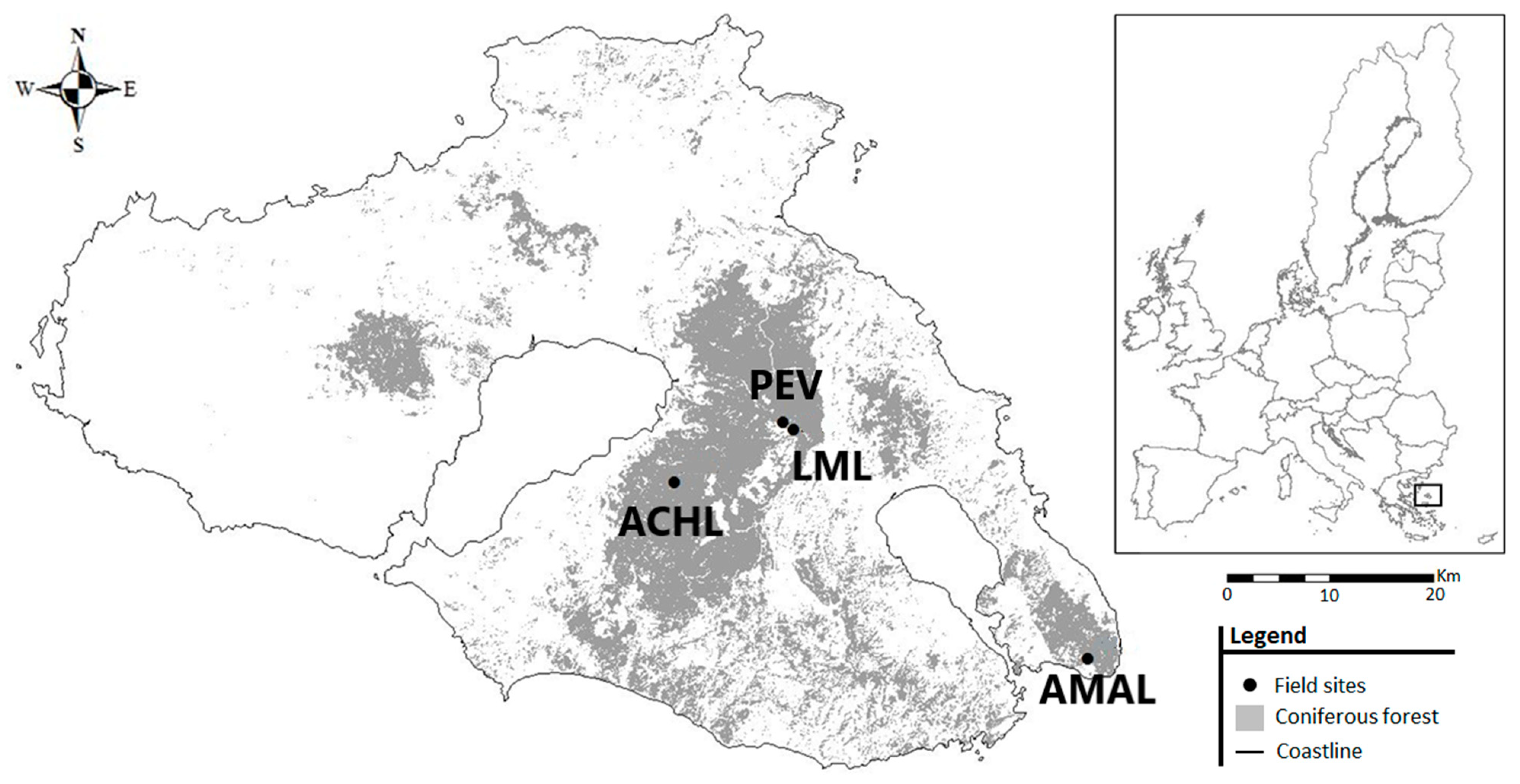
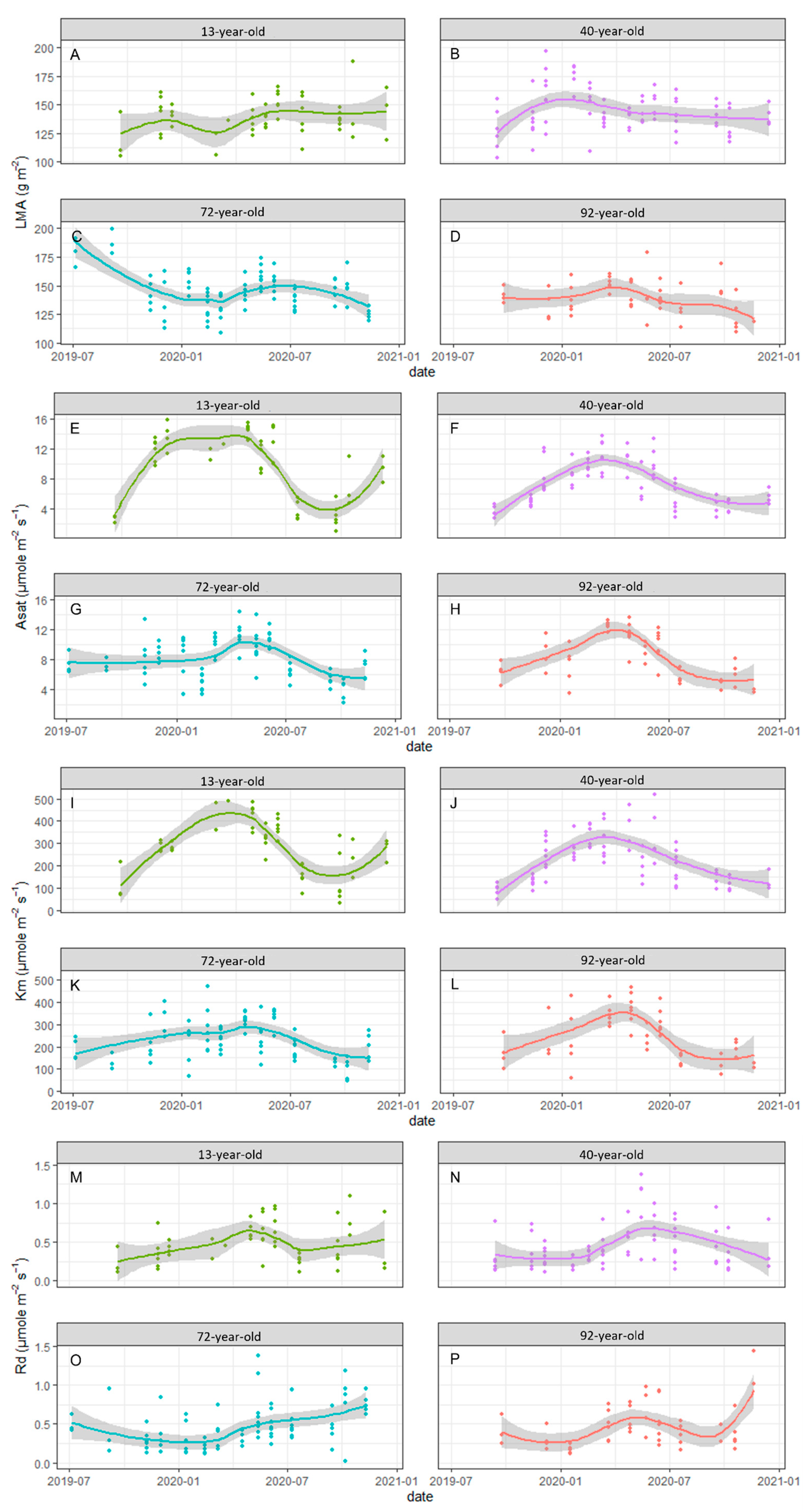
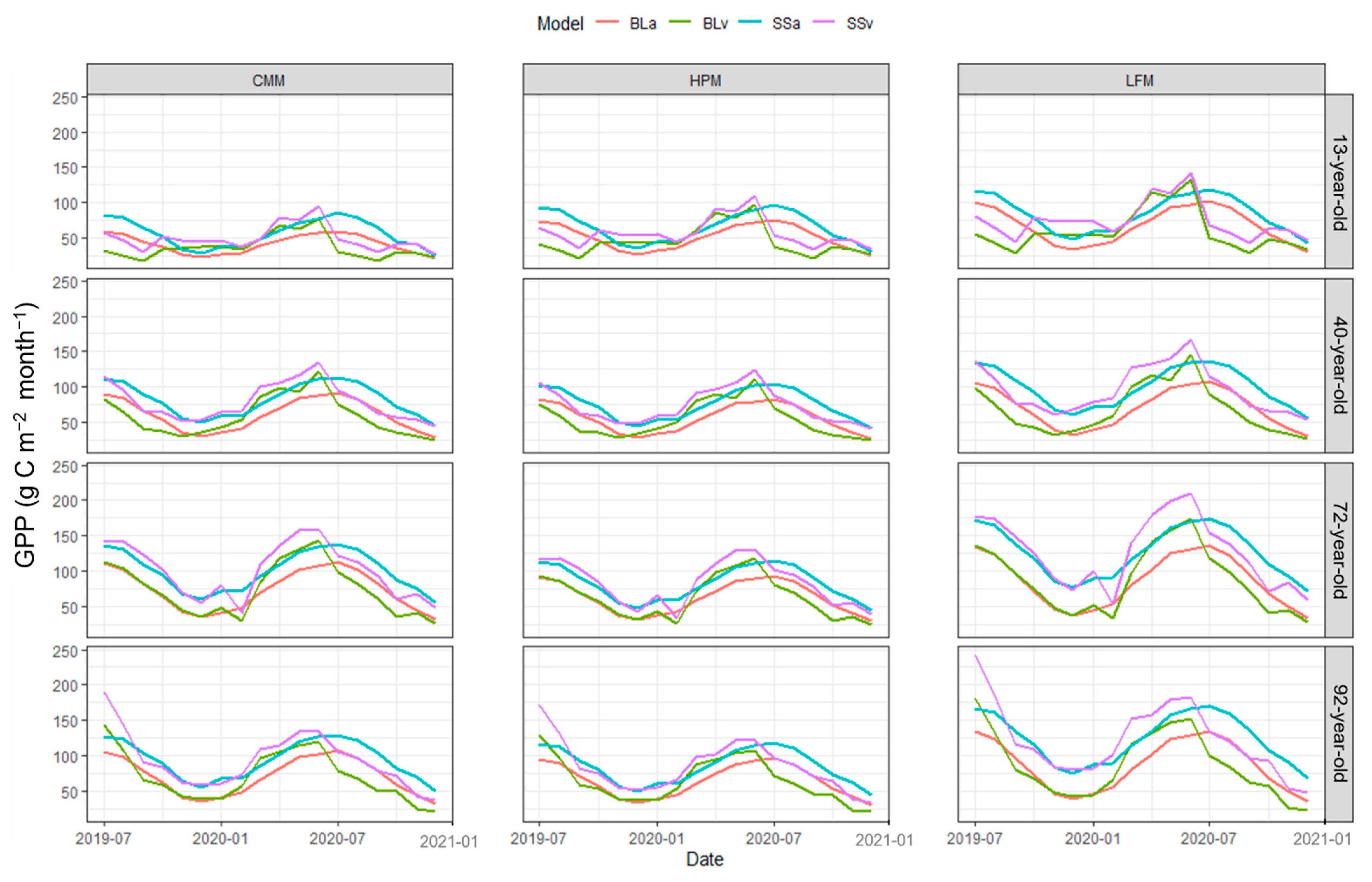
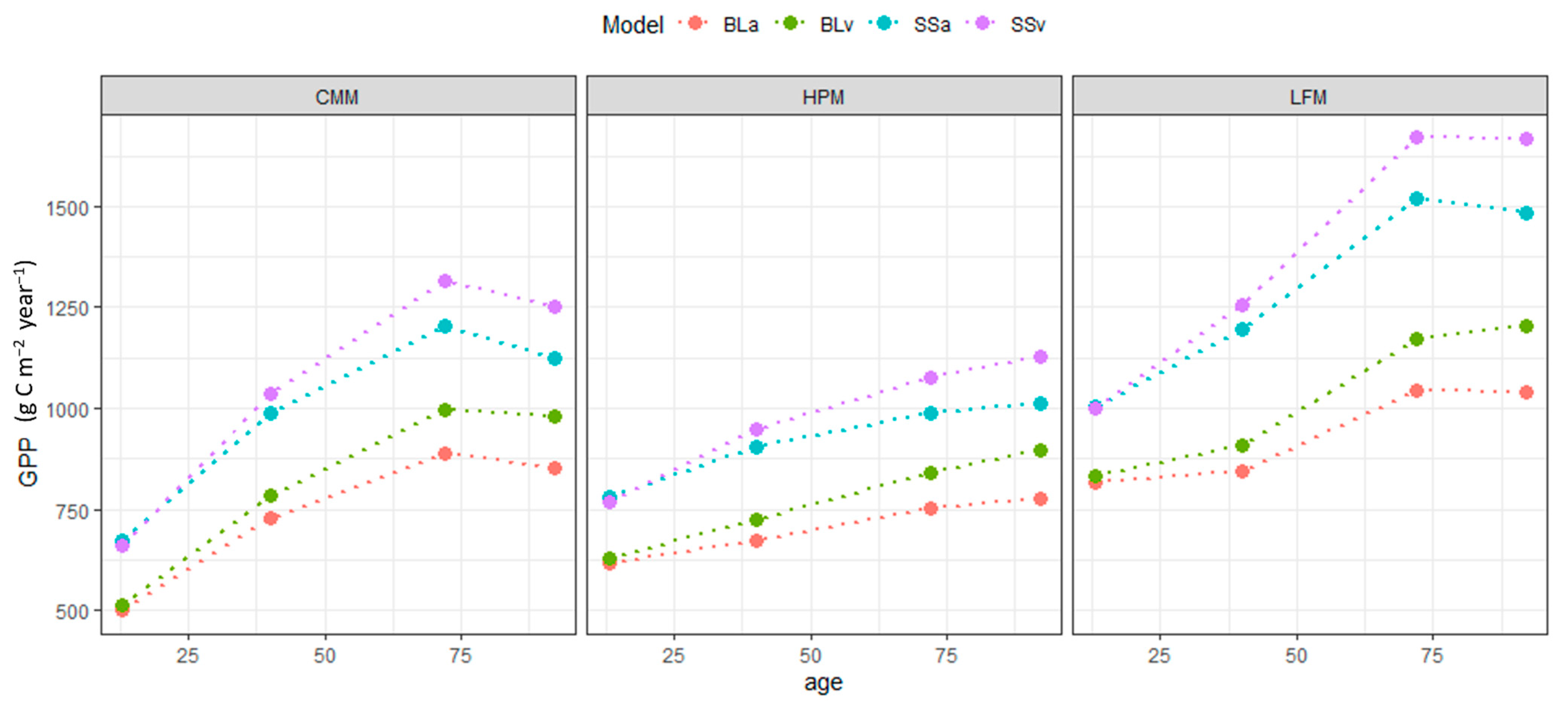
| Plot | Lat 1 | Lon 1 | Stand Age (y) | Inclination % | Orientation |
|---|---|---|---|---|---|
| AMAL | 39.02 | 26.59 | 13 | 10 | SE |
| PEV | 39.16 | 26.37 | 40 | 5 | SW |
| LML | 39.16 | 26.38 | 72 | 10 | SW |
| ACHL | 39.13 | 26.30 | 92 | 0 | - |
| Model | Photosynthetic Capacity Setups | LAI Setups |
|---|---|---|
| Big Leaf (BL) Model | Monthly (variant) photosynthetic light response parameters | HPM |
| LFM | ||
| CMM | ||
| Annual (average) photosynthetic light response parameters | HPM | |
| LFM | ||
| CMM | ||
| Sun/Shade (SS) Model | Monthly (variant) photosynthetic light response parameters | HPM |
| LFM | ||
| CMM | ||
| Annual (average) photosynthetic light | HPM | |
| LFM | ||
| CMM |
| Stand Age (Years) | Mean Tree Height (m) | Trees/Plot (no/900 m2) | Mean dbh (cm) | Basal Area (m2 ha−1) | LAI Method | ||
|---|---|---|---|---|---|---|---|
| HPM | LFM | CMM | |||||
| 13 | 1.93 | 99 | 1.98 | 0.59 | 0.90 | 1.47 | 0.66 |
| 40 | 5.46 | 300 | 7.46 | 22.87 | 1.48 | 2.66 | 1.77 |
| 72 | 9.28 | 62 | 20.72 | 32.92 | 1.45 | 3.88 | 2.13 |
| 92 | 12.87 | 21 | 43.36 | 35.79 | 1.47 | 3.36 | 1.79 |
| Parameter | 13 Year-Old | 40 Year-Old | 72 Year-Old | 92 Year-Old | AICplot | AICplot+month | ΔAIC |
|---|---|---|---|---|---|---|---|
| LMA | 139.3 (±4.5) | 146.4 (±4.4) | 142.5 (±4.4) | 139.0 (±3.3) | 2253 | 2231 | −22 |
| Asat | 10.9 (±1.3) | 5.9 (±1.3) | 8 (±1.4) | 7.9 (±1.0) | 1395 | 1207 | −188 |
| Km | 303.4 (±37.4) | 223.3 (±36.9) | 235.6 (±38.2) | 239.4 (±27.9) | 3235 | 3121 | −114 |
| Rd | 0.53 (±0.1) | 0.48 (±0.1) | 0.45 (±0.1) | 0.49 (±0.07) | 158 | 111 | −47 |
| GPP Model | LAI Method | Photo Capacity | 13 Year-Old | 40 Year-Old | 72 Year-Old | 92 Year-Old |
|---|---|---|---|---|---|---|
| Big Leaf Model | HPM | variant | 630 | 724 | 840 | 895 |
| LFM | variant | 830 | 910 | 1172 | 1204 | |
| CMM | variant | 511 | 785 | 996 | 982 | |
| HPM | average | 616 | 674 | 751 | 778 | |
| LFM | average | 816 | 846 | 1043 | 1042 | |
| CMM | average | 499 | 730 | 890 | 852 | |
| Sun/Shade Model | HPM | variant | 767 | 945 | 1075 | 1125 |
| LFM | variant | 999 | 1255 | 1670 | 1667 | |
| CMM | variant | 658 | 1036 | 1315 | 1252 | |
| HPM | average | 779 | 903 | 987 | 1012 | |
| LFM | average | 1004 | 1195 | 1519 | 1483 | |
| CMM | average | 673 | 989 | 1205 | 1124 | |
| Zhang et al. (2017) | - | - | 816 (±98.7) | 1221 (±126.5) | 1221 (±126.5) | 1060 (±102.1) |
Publisher’s Note: MDPI stays neutral with regard to jurisdictional claims in published maps and institutional affiliations. |
© 2021 by the authors. Licensee MDPI, Basel, Switzerland. This article is an open access article distributed under the terms and conditions of the Creative Commons Attribution (CC BY) license (https://creativecommons.org/licenses/by/4.0/).
Share and Cite
Sazeides, C.I.; Christopoulou, A.; Fyllas, N.M. Coupling Photosynthetic Measurements with Biometric Data to Estimate Gross Primary Productivity (GPP) in Mediterranean Pine Forests of Different Post-Fire Age. Forests 2021, 12, 1256. https://doi.org/10.3390/f12091256
Sazeides CI, Christopoulou A, Fyllas NM. Coupling Photosynthetic Measurements with Biometric Data to Estimate Gross Primary Productivity (GPP) in Mediterranean Pine Forests of Different Post-Fire Age. Forests. 2021; 12(9):1256. https://doi.org/10.3390/f12091256
Chicago/Turabian StyleSazeides, Christodoulos I., Anastasia Christopoulou, and Nikolaos M. Fyllas. 2021. "Coupling Photosynthetic Measurements with Biometric Data to Estimate Gross Primary Productivity (GPP) in Mediterranean Pine Forests of Different Post-Fire Age" Forests 12, no. 9: 1256. https://doi.org/10.3390/f12091256
APA StyleSazeides, C. I., Christopoulou, A., & Fyllas, N. M. (2021). Coupling Photosynthetic Measurements with Biometric Data to Estimate Gross Primary Productivity (GPP) in Mediterranean Pine Forests of Different Post-Fire Age. Forests, 12(9), 1256. https://doi.org/10.3390/f12091256








